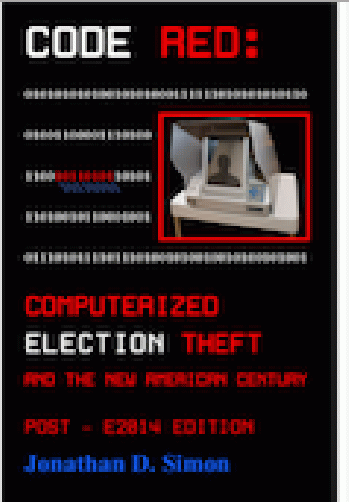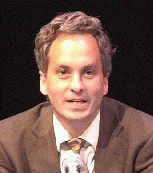My guest today is Jonathan Simon, co-founder of Election Defense Alliance and author of CODE RED: Computerized Election Theft and The New American Century. Welcome back to OpEdNews, Jonathan.
Joan Brunwasser: So, here we are in the middle of the 2016 presidential primaries. How're we doing, election integrity-wise?
Jonathan Simon: First, thanks for asking me back for another round, Joan. It's one of those quadrennial "presidential" years so a lot of attention is being focused on the electoral system and things that go bump in the electoral night. Unfortunately, enormous and enduring damage has been done during the intervening "off" years in which the infrastructure of American politics--Congress, state legislatures, judgeships, and state and local administrations--has been set in down-ballot contests that receive little or no scrutiny and can be manipulated with essentially no risk of detection.
But here we are in the midst of one of the most bizarre presidential campaigns in memory and, to answer your question directly, election integrity has not been one of the winners. Over the years, I've encountered such a consistently icy reception from "serious" journalists to the presentation of any evidence, however compelling, of actual electronic votecount manipulation that I have come to frame my appeals to public consciousness less in terms of declarative proofs of fraud and more in terms of the risk we face as long as we acquiesce in the unobservable counting of our votes by a few shadowy corporations. That point at least occasionally resonates, while presenting evidence of actual electoral cybertheft, even though all sorts of cybertheft are rampant in our time, seems to throw up a towering wall.
So it was with a resignation born of long experience that I began to gather data and analyze the patterns from the 2016 primaries. What I have found has been enough to put me back in the "proving fraud" business. Because this year's primaries have presented a pattern that, quite simply, defies benign explanation.
JB: Well, that was certainly a provocative opening and recap, Jonathan. You've got our attention. Now, please explain your last sentence.
JS: Looking at the patterns of votecounts and exit poll results for the 2016 primaries, there are two major "sore-thumb" indicators of electronic interference with the tabulation of votes on the Democratic side. I want to put this in the context of the revived and heated debate about the validity and utility of exit polling as a check on the validity of the votecounts. There are some who continue to claim that U.S. exit polls are always "off" and useless because, they say, in this country unlike in other countries, exit polls are not "designed" to be accurate mirrors of the votecounts (which, if it were true, would of course beg the obvious question: "Why not?"). They would have a very hard time explaining the data from the 2016 primaries.
Because somehow the exit polls managed to be consistently accurate through the whole run of Republican primaries.
JB: Really? That's weird. How does that work?
JS: Through New York, after which the respective nomination contests were effectively decided, the exit polls on the Republican side matched front-runner Trump's votecounts within an average of 1.5%. This modest disparity, well within the average margin of error of the polls, is just what we would expect if the votecounts were accurate. On the Democratic side, in stark contrast, the average exit poll-votecount disparity was a whopping 6.6%!
Not only were 16 of the 18 disparities in the same direction, a shift of votecounts from Sanders to Clinton, but eight of the 18 disparities were outside the poll margins of error. According to the laws governing probability, the likelihood of exceeding the margin of error is 1/20 for each poll; thus 17 of the 18 polls should have been within the margin of error and the likelihood of eight outside the margin of error is on the order of one in a million.
This looks very much like the pattern we observed in elections from 2004 through 2014, which we dubbed the "red shift" because it was virtually always in favor of the Republican candidate. Here we see it turning up in an intra-party context (here I should note that the "beneficiary" of electoral manipulation is not necessarily the "perpetrator:" there are, for example, bad actors other than Clinton herself with strong motivation to derail the Sanders candidacy). The utterly different performances of the exit polls, following the same protocols, on the Democratic and Republican sides in 2016 puts the lie to the general disparagement of exit polls. It is bordering on ridiculous to postulate that the exit pollsters, all of a sudden in 2016, know what they are doing when they sample Republicans but not Democrats.

Code Red: Computerized Election Theft and the New American Century
(Image by courtesy of Jonathan Simon) Details DMCA
JB: Hmmm.... What else have you got?
JS: The second big red flag is Oklahoma. The two states out of 18 shifted "the other way," from Clinton to Sanders, were Wisconsin (a 1.9% disparity) and Oklahoma (a 6.1% disparity, less than a one-in-ten likelihood of occurring). Why is this compelling? Because outlier Oklahoma is the only state among all these states in which the state, rather than the vendors, programs the vote counting computers.
(Note: You can view every article as one long page if you sign up as an Advocate Member, or higher).






